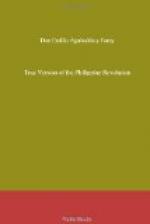With regard to the rising in the province of Cavite it should be stated that although a call to arms bearing the signatures of Don Augustin Rieta, Don Candido Firona and myself, who were Lieutenants of the Revolutionary Forces, was circulated there was no certainty about the orders being obeyed, or even received by the people, for it happened that one copy of the orders fell into the hands of a Spaniard named Don Fernando Parga, Military Governor of the province, who at that time was exercising the functions of Civil Governor, who promptly reported its contents to the Captain-General of the Philippines, Don Ramon Blanco y Erenas. The latter at once issued orders for the Spanish troops to attack the revolutionary forces.
It would appear beyond doubt that One whom eye of man hath not seen in his wisdom and mercy ordained that the emancipation of the oppressed people of the Philippines should be undertaken at this time, for otherwise it is inexplicable how men armed only with sticks and gulok [1] wholly unorganized and undisciplined, could defeat the Spanish Regulars in severe engagements at Bakoor, Imus and Noveleta and, in addition to making many of them prisoners, captured a large quantity of arms and ammunition. It was owing to this astonishing success of the revolutionary troops that General Blanco quickly concluded to endeavour, to maintain Spanish control by the adoption of a conciliatory policy under the pretext that thereby he could quel the rebellion, his first act being a declaration to the effect that it was not the purpose of his Government to oppress the people and he had no desire “to slaughter the Filipinos.”.
The Government of Madrid disapproved of General Blanco’s new policy and speedily appointed Lieutenant-General Don Camilo Polavieja to supersede him, and despatched forthwith a large number of Regulars to the Philippines.
General Polavieja advanced against the revolutionary forces with 16,000 men armed with Mausers, and one field battery. He had scarcely reconquered half of Cavite province when he resigned, owing to bad health. That was in April, 1897.
Polavieja was succeeded by the veteran General Don Fernando Primo de Rivera, who had seen much active service. As soon as Rivera had taken over command of the Forces he personally led his army in the assault upon and pursuit of the revolutionary forces, and so firmly, as well as humanely, was the campaign conducted that he soon reconquered the whole of Cavite province and drove the insurgents into the mountains.
Then I established my headquarters in the wild and unexplored mountain fastness of Biak-na-bato, where I formed the Republican Government of the Philippines at the end of May, 1897.
CHAPTER II
The Treaty of Biak-na-bato
Don Pedro Alejandro Paterno (who was appointed by the Spanish Governor-General sole mediator in the discussion of the terms of peace) visited Biak-na-bato several times to negotiate terms of the Treaty, which, after negotiations extending over five months, and careful consideration had been given to each clause, was finally completed and signed on the 14th December, 1897, the following being the principal conditions:—




